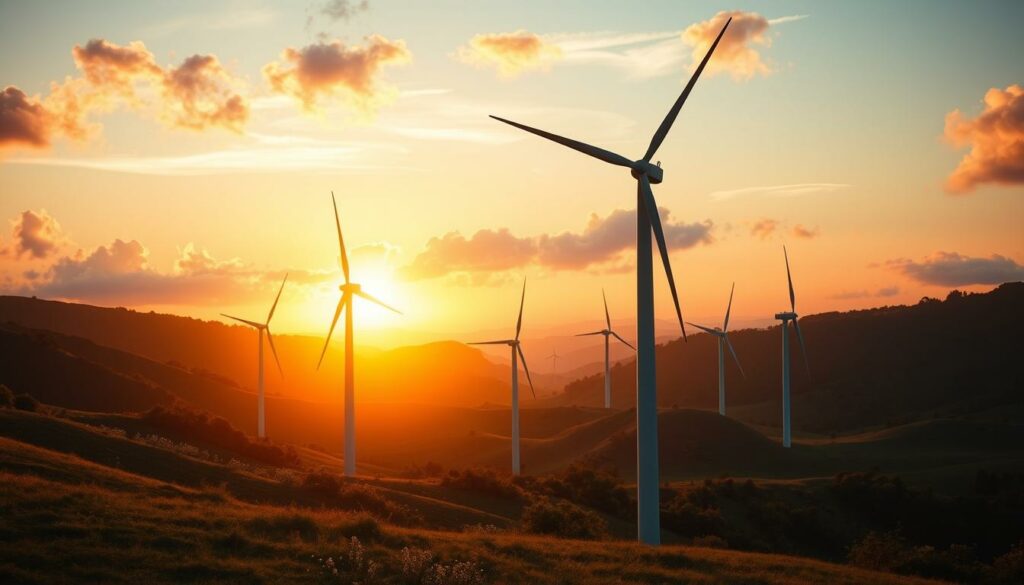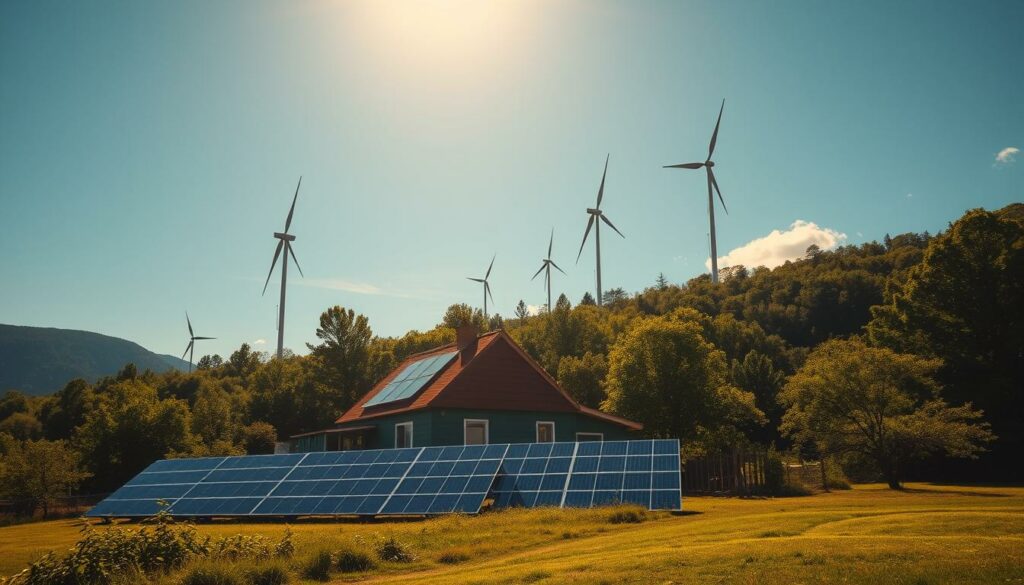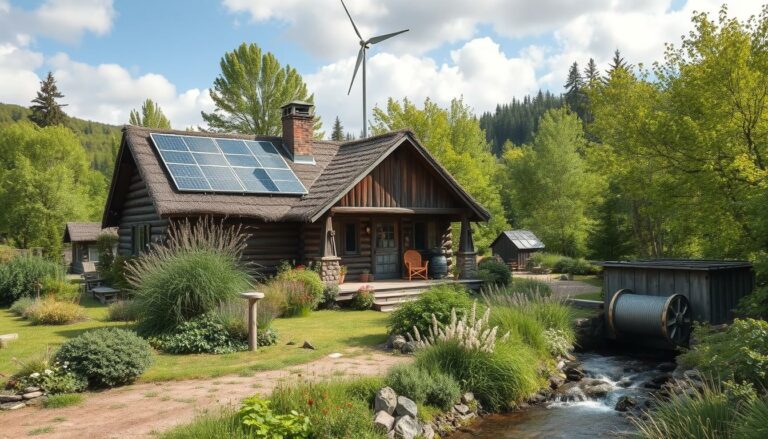In today’s world, power cuts and high electricity bills are common. DIY renewable energy is key for those who want to live sustainably and be self-sufficient. By making your own solar, wind, or hydropower systems, you can have a steady energy supply.
More than 70% of people without grid power use solar energy. This is because DIY solar panels can save up to 80% compared to store-bought ones. Switching to off-grid can also cut down energy use by 25-50%, thanks to better energy-saving habits.
Places with steady winds can get 20-40% of their energy from wind power. Using both solar and wind energy can make your power supply even more reliable, by up to 50%. Preparing for energy independence means more than just using renewable energy. It’s about building a sustainable future.
Key Takeaways
- Embracing DIY renewable energy can significantly reduce household energy consumption and costs.
- DIY solar panel installations can save up to 80% compared to commercial options.
- Combining renewable energy sources increases overall energy reliability.
- Proper energy storage systems can reduce power outages by 40-70%.
- Wind energy is viable for locations with consistent wind patterns, contributing up to 40% of energy needs.
Understanding DIY Renewable Energy
DIY renewable energy lets families and individuals cut down on traditional power. It uses natural resources like solar, wind, and water. These projects can make electricity and bring big benefits.
What is DIY Renewable Energy?
DIY renewable energy means making your own power using natural resources. You can use solar panels, wind turbines, or micro-hydro systems. This way, you can make your own electricity.
By using renewable energy, you can be more independent. You also help the planet by using less fossil fuels. Plus, you can make a system that fits your needs and where you live.
Benefits of DIY Renewable Energy
DIY renewable energy has many good points:
- Cost Savings: You can save a lot on electricity bills. Solar energy can cut costs by 50-80%.
- Environmental Impact: It helps reduce harmful emissions. This is good for the planet.
- Self-Sufficiency: You don’t need the main power grid. This is great for those in remote areas or preppers.
- Flexibility and Customization: You can make a system that fits your home and local area.
Renewable Energy Sources Overview
There are many sources for DIY renewable energy projects. Each has its own benefits:
- Solar Power: Solar panels turn sunlight into electricity well. A good solar system can power a whole house in sunny places.
- Wind Energy: Small wind turbines are cost-effective. They can make 400 to 1,200 kWh a year, depending on where you are.
- Micro-Hydro Power: Micro-hydro systems can make up to 100 kilowatts. They’re good for places with flowing water. A 10-kilowatt system can power a big house or small resort.
Knowing about these sources helps choose the best one for you. Always check local rules and building codes before starting a DIY renewable energy project.
Solar Power for Preppers
Solar power is a reliable and sustainable energy source for preppers. It’s key to know how to pick the right solar panels and build DIY systems. Also, keeping them in good shape is important for the best performance.
Choosing Solar Panels
When picking solar panels, look at their efficiency and how much power they can make. Most panels make about 200 watts, but better ones can make more. For a typical home using 30 kilowatt-hours a day, you need to figure out how many panels you need.
It’s best to aim for enough power to fill batteries for at least five hours a day in sunny places. Make sure to point your panels south and tilt them right for your area to get the most power. Also, using the 30% federal tax credit and local incentives can help lower costs.
Building Your Own Solar Setup
Building a DIY solar system needs careful planning. First, find the best spot for your panels to get the most sun. A good setup, like the Off Grid Ham 100 Watts Solar Energy Plant, includes:
- Renogy 100 watt solar panel: $129.00
- Morningstar 10 amp PWM controller: $48.00
- Power-Sonic 26 amp-hour SLA battery: $59.00
- 20 foot MC4 cable: $15.00
- Assorted wire, connectors, hardware, taxes, and shipping fees: $49.00
The total cost is about $300.00. It can make 80 to 85 watts, thanks to the PWM controller. Even though it’s not as efficient as an MPPT controller, it’s cheaper and works well for keeping power needs over 50 watts up under bright sun.
Maintenance Tips for Solar Installations
Keeping your solar system in good shape is key to its long life and performance. Here are some important tips:
- Routine Cleaning: Keep your panels clean to keep them working well.
- Damage Inspection: Check for cracks, loose connections, and water damage regularly.
- System Monitoring: Watch the battery voltage and make sure it goes up when the panel is in sunlight.
Following these tips will help your DIY solar systems work well for many years. They usually last about 30 years.
Wind Energy Solutions
Wind energy is key for preppers’ renewable energy systems. It’s important to know about DIY wind turbines, picking the right spots, and safety during setup.

Basics of DIY Wind Turbines
DIY wind turbines are a hit with those wanting green power. They are usually horizontal-axis machines with two or three blades made of fiberglass. These turbines can cut electricity costs by 50%–90% and keep power on during long outages.
For a wind system, you need a controller, batteries, an inverter, wiring, and a grounding system.
Selecting Optimal Locations for Turbines
Finding the right spot is key for wind energy. Wind speeds go up with height, so tower height matters a lot. Towers can stand alone or be supported by guys, with tilt-down towers being easier to maintain but pricier.
The size of the rotor and the “swept area” of the turbine affect how much energy it makes. Preppers should check wind speeds in their area to find the best spots for turbines.
Safety Measures When Installing Wind Energy Systems
Keeping safe while setting up DIY wind turbines is a must. Make sure the tower foundation is solid and use the right grounding to avoid electrical dangers. Regular checks and upkeep, even in bad weather, can help avoid risks.
Builders should use strong materials and parts that can handle high winds. This ensures your wind turbine system lasts long and works well.
Harnessing Hydropower
Hydropower is a great choice for renewable energy in preparedness. It uses water flow to generate power, making it reliable and efficient. If you have a water source, micro-hydro systems can help you produce small-scale energy.
Micro-Hydro Systems Explained
Micro-hydro systems use water flow to make electricity. They’re perfect for small communities or homes. Unlike big hydropower plants, they need less setup and work well with other green energy.
These systems have a high capacity factor, around 40-60%. This means they’re more reliable than solar or wind power.
Site Considerations for Hydropower
Finding the right spot is key for hydropower systems. It needs steady water flow and enough fall. You also have to think about local ecosystems and sedimentation.
Mountainous areas with strong currents are best for hydropower. The right site ensures good energy and protects the environment.
Cost-Effective DIY Hydropower Solutions
DIY hydropower is a smart choice for preppers. It’s cost-effective and helps you be self-sufficient. Hydropower systems last over 50 years, making them a good investment.
Starting a DIY micro-hydro system takes some money for turbines and generators. But, it saves money and is good for the planet in the long run.
Energy Storage Options
Effective energy storage is key for using renewable power. There are many types of batteries, each with its own benefits and drawbacks.
Understanding Battery Types
Choosing the right battery is important for storing energy well. Here are some common types:
- Lead-Acid Batteries: Known and affordable but need regular care.
- Lithium-Ion Batteries: Very efficient and last long but cost more.
- Flow Batteries: Great for big storage needs, but not common at home.
Building Your Own Battery Bank
Building a DIY battery bank needs careful planning and electrical knowledge. Here’s how to make your own home energy storage:
- Figure out how much energy you need and how much storage you need.
- Pick the right batteries based on your budget and how efficient you need them to be.
- Put batteries together in the right way to match your needs for voltage and capacity.
- Make sure there’s good air flow and safety measures to avoid overheating or short circuits.
Battery banks are key in off-grid systems. They let you store energy for when you need it most.
Maintenance of Energy Storage Systems
Keeping your energy storage systems in good shape is important:
- Check battery connections and terminals often for corrosion.
- Keep all battery charge levels balanced to wear them evenly.
- Use a Battery Management System (BMS) to check battery health.
- Replace any failing batteries quickly to keep your battery banks working well.
| Battery Type | Cost | Lifespan | Efficiency |
|---|---|---|---|
| Lead-Acid | $200 – $600 | 3 – 5 years | 70-85% |
| Lithium-Ion | $1,000 – $3,000 | 10 – 15 years | 95-98% |
| Flow Batteries | $700 – $1,500 | 10+ years | 75-85% |
Keeping your energy storage systems in good shape helps you use less grid electricity. It also helps you save money by using energy when it’s cheaper.
Preparing for Energy Independence
To achieve energy independence, you need to plan carefully and understand your energy use. Using different renewable energy sources helps ensure a steady and green energy supply.
Assessing Your Energy Needs
Start by looking at how much energy you use each month. Find out when you use the most energy. Keep track of your energy use for a whole year to see how it changes with the seasons. You should gather data on:
- Total energy usage in kWh.
- Daily and monthly consumption patterns.
- Energy needs for essential appliances.
Smart meters can make tracking your energy use easier. They give you the exact data you need for your green energy plans.

Creating a Sustainable Energy Plan
Your green energy plan should mix different renewable sources based on your location and environment. Think about adding:
- Solar Panels: They’re getting cheaper and can be a good choice. For example, 9 panels with a 3.6 kW hybrid inverter can make up to 1,400 kWh a year.
- Wind Turbines: They work best in places with steady wind. They turn wind into electricity well.
- Hydropower: It can add power to the grid right away and be a backup during power outages.
Having a plan that uses these sources makes your energy system strong and independent. Remember to follow the law and get the right permits and meet local rules.
Combining Renewable Sources for Efficiency
Using more than one energy source makes your system better and more reliable. A mix of solar, wind, and hydropower can handle different weather, keeping your energy flowing. Here’s a quick look at how they compare:
| Energy Source | Initial Cost | Annual Energy Output | Maintenance | Additional Benefits |
|---|---|---|---|---|
| Solar Power | $15,000 | 1,400 kWh | Low | Reduces electricity bills |
| Wind Energy | $10,000 | 2,000 kWh | Medium | Energy generation during cloudy days |
| Hydropower | $25,000 | 5,000 kWh | High | Supports irrigation and flood control |
By carefully choosing and combining these renewable sources, you can build a strong energy system. Going green not only makes your energy use more secure but also helps the planet and boosts the economy.
Off-Grid Living Essentials
Off-grid living is appealing to many who want to use less public utilities. It’s key to know several important things for a successful life. Energy needs, resources, and climate are big factors. Let’s look at the basics of off-grid living.
Key Considerations for Off-Grid Energy
Understanding your energy needs and resources is vital for off-grid living. The cost for solar systems can be from $10,000 for small homes to over $75,000 for bigger ones. Wind energy is also an option, costing between $3,000 and $8,000 per turbine, if wind speeds are high enough.
Hydropower is efficient but needs steady water flow, so picking the right spot is important. Biomass energy, with efficiency rates of 20% to 80%, depends on the biomass type and technology. These renewable sources are the foundation for a strong off-grid energy system, making off-grid living more possible.
Essential Tools and Equipment
Having the right essential survival tools is key for off-grid living success. Here are some must-haves:
- Solar Panels and Inverters
- Wind Turbines
- Hydropower Generators
- Battery Storage Systems
- Water Filtration and Rainwater Harvesting Systems
- Composting Toilets
- Hand Tools for Maintenance
- First Aid Kits
To be fully self-sufficient, consider systems for water, waste, and food. For example, composting can cut waste by up to 30%. Rainwater harvesting in areas with enough rain can collect 1,500 to 2,000 gallons a year.
Legal and Permitting Factors
Understanding the legal side of off-grid living is vital. You must know and follow local rules on energy systems, water use, and land use. Here are the main legal considerations:
| Aspect | Details |
|---|---|
| Energy Systems | Permits for solar, wind, or hydropower installations; compliance with local building codes. |
| Water Usage | Regulations for well water usage and rainwater harvesting practices. |
| Land Development | Zoning laws and land use permits. |
| Waste Management | Approvals for composting toilets and septic systems. |
Knowing these factors and following local laws ensures your off-grid project goes smoothly and legally. As more people choose off-grid living, it’s becoming more popular. With the right planning and tools, moving to an off-grid lifestyle can be rewarding and practical.
DIY Renewable Energy Projects
Starting DIY projects can be very rewarding for those who love renewable energy. Whether you’re new to sustainable living or have more experience, there’s a project for you. You can find something that fits your skill level and interests.
Simple Projects for Beginners
For beginners, there are easy projects to try. You can start by installing small solar panels to charge batteries or power small appliances. Solar panels are easy to use and can be placed on roofs or in backyards.
Another simple project is building a hand-cranked generator or a human-powered laundry machine. These projects show how to generate energy manually.
Here are some beginner renewable energy projects:
- LED bulb installations – Use up to 75% less energy than traditional bulbs.
- Programmable thermostats – Reduce heating and cooling bills by up to 30%.
- Low-flow showerheads – Reduce water flow by up to 50%.
- DIY solar gadget charger – Cost around $150 and ideal for small devices.
Intermediate DIY Renewable Energy Projects
Intermediate projects are a bit more challenging. Building a micro-hydro power system is a great example. These systems use water flow to generate electricity, perfect for homes near water.
Intermediate projects include:
- Solar water heaters – Provides hot water within hours.
- DIY hydro power water wheel – Generates about 50% of electrical needs.
- Home insulation improvements – Can save up to 30% on heating costs.
- Wood gas generators – Maximize energy by capturing thermal and combustible gas.
Advanced Projects for Enthuasiasts
For those with advanced skills, there are complex DIY projects. Building wind turbines like the dual-axial flux generator is one example. It can produce 50-100W of power. Another project is using microbial fuel cells to generate electricity from anaerobic bacteria.
Some advanced energy solutions include:
| Project | Details |
|---|---|
| Wind Turbine Systems | Output between 50-100W, high-efficiency small-scale power. |
| Microbial Fuel Cells | Anaerobic bacteria can generate electrical current; emerging tech. |
| Kite Power Systems | Uses surf kites in figure-eight patterns to capture energy. |
| Solar Trackers | Utilizes four light-dependent resistors for optimal alignment. |
Resources and Learning Materials
To start DIY renewable energy projects, you need many educational resources. Each one gives you special insights. This ensures you know a lot and can do things practically.
Books and Guides for DIY Renewable Energy
Books and guides are key for those into renewable energy. They dive deep into the subject, from basics to advanced DIY methods. For example, the Renewable Energy Science Kit lets you do 10 experiments. It covers Chemistry and Physics well.
The kit comes with a 100-page Teacher’s Guide and a 76-page Student’s Guide. Both are packed with learning materials.
| Item | Details |
|---|---|
| Renewable Energy Science Kit | Includes materials for 10 class periods of experimentation, priced at $329. |
| Teacher’s Guide | 100 pages of instructional resources |
| Student’s Guide | 76 pages of educational content |
| Horizon Energy Monitor (add-on) | Costs $289, enhances practical learning |
Online Communities and Forums
Joining online communities and forums can really help. They offer support and experiences from others. Sites like Build It Solar and Clean Energy Authority have lots of DIY projects and learning resources.
These places are full of guides for setting up and installing renewable energy systems.
Workshops and Courses
Workshops and courses are great for learning by doing. They let you learn from experts in a fun and practical way. Places like the National Renewable Energy Laboratory (NREL) and U.S. Department of Energy’s Energy.gov have many workshops.
They teach the newest ideas and methods in renewable energy.
Combining books, online materials, workshops, and community involvement is key. It builds a solid base for any DIY renewable energy project.
Future Trends in Renewable Energy
Looking ahead, renewable energy is set for exciting changes. DIY tech innovations will make it easier for people to use renewable energy. Community projects are also growing, showing how we can work together for a greener future. It’s important to get ready for these changes to keep our energy use strong.
Innovations in DIY Technology
DIY renewable energy is getting better and cheaper. In 2023, the world’s renewable energy capacity jumped by 50%. Solar power is leading this growth. By 2028, solar and wind power in big places like the US and India will likely double.
The Role of Community Projects
Community projects are key in the move to clean energy. They bring people together to make a big difference. These efforts can cut down on pollution and create jobs.
With the right support, these projects can power millions of homes. The White House aims to make 30 gigawatts of wind power by 2030.
Preparing for Challenges Ahead
Renewable energy’s future looks bright, but we must face challenges head-on. We need better ways to store energy, like advanced batteries. This will help deal with the ups and downs of solar and wind.
Thanks to better forecasting, we’re using more wind and solar power. As tech improves, we must keep up. This means using smart grids and energy-saving gadgets to make our energy systems reliable.
Source Links
- https://sites.google.com/view/the-diy-prepper/how-to-build-an-off-grid-power-supply
- https://uspreppers.com/the-uspreppers-guide-to-generating-alternative-electricity/
- https://www.ruralsprout.com/produce-renewable-energy/
- https://www.energy.gov/energysaver/planning-home-renewable-energy-systems
- https://www.altestore.com/pages/learn-about-renewable-energy?srsltid=AfmBOoqZG2WMfcqGxnOpPAUBpdp5NThDi8GnsjPRytTJMRe9tI5IuEAA
- https://uspreppers.com/solar-power/
- https://offgridham.com/2016/02/the-off-grid-ham-100-watts-for-300-solar-energy-plant/
- https://www.energy.gov/energysaver/small-wind-electric-systems
- https://www.instructables.com/How-I-built-an-electricity-producing-wind-turbine/
- https://www.nrdc.org/stories/renewable-energy-clean-facts
- https://chariotenergy.com/blog/why-is-hydropower-the-best-energy-source/
- https://www.army.mil/article/271087/hydropower_harnessing_the_power_of_water_for_a_sustainable_future
- https://energysavingtrust.org.uk/advice/storing-energy/
- https://renewableheatinghub.co.uk/forums/energy-storage/a-beginners-journey-into-diy-home-energy-storage-no-solar
- https://preparedbee.com/pages/renewable-energy-solutions-guide-for-self-sufficiency?srsltid=AfmBOorN956mrWHFKOWRww_P7OA3NsWCK_LZDkKCGatJPDuDHUyoMCk7
- https://solarenergyconcepts.co.uk/practical-and-diy/diy-solar-installation-a-journey-to-energy-independence/
- https://todayshomeowner.com/electrical/guides/living-off-the-grid-generating-your-own-electricity/
- https://ecoshack.com/how-to-live-off-the-grid/
- https://theoffgridcabin.com/off-grid-living/
- https://smartenergy.com/diy-energy-efficiency-projects-for-the-weekend-save-energy-save-money/
- https://www.hackster.io/news/the-best-diy-renewable-energy-projects-on-hackster-e70d36bc05af
- http://envienta.net/renewables/8-completely-awesome-diy-home-energy-projects/
- https://www.horizoneducational.com/renewable-energy-science-kit/p1218
- https://www.lgcypower.com/the-best-tools-and-resources-to-learn-about-solar-energy/
- https://www.ibm.com/think/insights/renewable-energy-future
- https://www.thefashionablehousewife.com/the-future-of-renewable-energy-a-path-to-sustainability/

